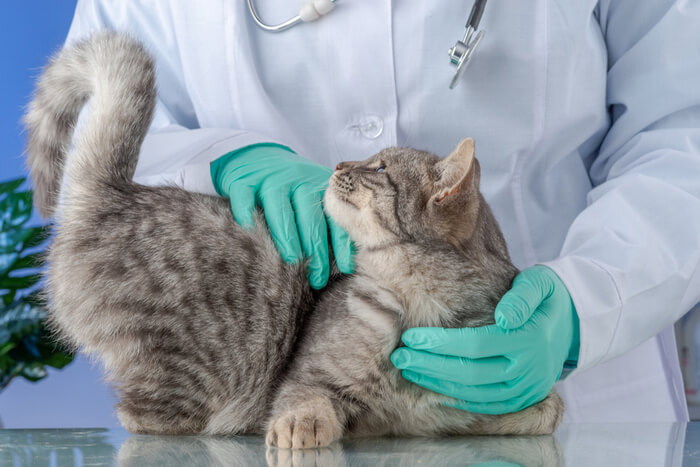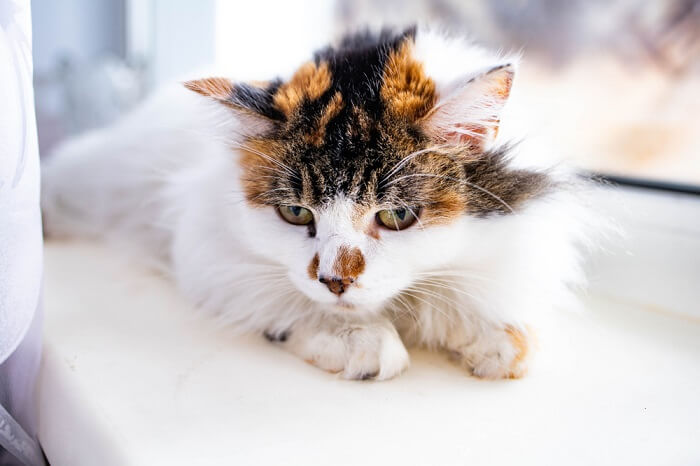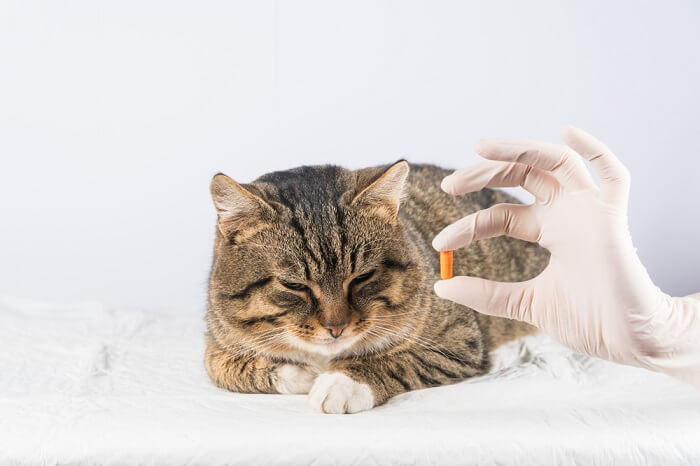
A diagnosis of liver failure in your cat can be worrying for cat owners: this article aims to give cat carers clear facts about what this means, and about the possible consequences for a cat’s health.
What Is Liver Failure?
A cat’s liver is a large solid organ at the front of the cat’s abdomen, just behind the diaphragm which separates the abdomen from the chest.
The liver has a wide range of functions in the body, playing a key role in the processing of food after it’s been absorbed from the intestines, as well as being involved in the processing of the waste products and metabolites that are produced during the body’s normal functioning.
- If the liver stops working properly, this is called liver disease, and cats can still appear to be in reasonable general health despite suffering from some degree of liver disease.
- If, however, the liver disease becomes more advanced, the liver is unable to continue to function due to the disease process, and this is termed “liver failure”.
- A cat with liver failure becomes obviously unwell, and needs urgent treatment.
What Causes Liver Failure?
There are two main types of common liver disease in cats that can lead to liver dysfunction and liver failure. These are classified as primary and secondary:
A. Primary liver disease can be due to a number of common causes
- Congenital abnormalities (which animals are born with) e.g. portosystemic shunt
- Bacterial infection (e.g. suppurative cholangitis or cholangiohepatitis), which often involves the liver, the gall bladder, and the bile duct, which are closely linked anatomically.
- Immune-system-related liver disease, in particular lymphocytic cholangitis, which is often linked to two other related inflammatory conditions, pancreatitis and inflammatory bowel disease (IBD), resulting in a condition commonly referred to as “triaditis”.
- Feline Infectious Peritonitis (FIP)
- Toxic damage to the liver: a number of toxins may cause liver damage
- Hepatic lipidosis also known as fatty liver disease (linked to obesity, when the liver becomes infiltrated with abnormal fatty tissue in obese cats)
- Tumors, both benign and malignant, including lymphoma
B. Secondary liver disease can occur with a number of conditions
The liver can commonly be adversely affected by other diseases, such as:
- Pancreatitis
- Diabetes Mellitus
- Hyperthyroidism
- Other conditions such as heart disease, kidney disease etc.
What Are the Signs of Liver Disease?

Your cat’s history is important in determining the cause of liver failure: senior cats are more prone to some issues than younger cats, cats that are free-ranging than indoor-only cats, too, etc.
In the early stages, liver problems may be asymptomatic (there may be no external clinical signs), but as the liver disease advances to become a liver failure, signs of illness become increasingly obvious.
These include:
- Loss of appetite (not eating as much as normal) or even anorexia (not eating at all)
- Polydipsia (excessive drinking of water)
- Dullness
- Weight loss
- Drooling, excessive salivation
- Gastrointestinal signs such as vomiting and diarrhea
- Swollen abdomen, also known as ascites
- Jaundice (yellowing of the mucous membranes)
- Delays in blood clotting, because the liver has a role in this process
How Does a Dvm Veterinarian Approach a Case of Liver Failure?
1. Detailed History Taking
Your vet will discuss every aspect of your cat’s condition and review its overall health. There are a number of different possible causes of the signs of liver failure, and this careful history gathering will help to pinpoint the cause.
Many factors are important in this history e.g. senior cats are more prone to certain problems than younger cats, cats that are free-ranging are more prone to some problems than indoor-only cats, etc. A dietary history is important: what sort of cat food does your cat eat?
Has a new food been started recently? Are they being fed any supplements? Are there any other factors that could be affecting their digestive system? Is the cat urinating normally? (cat owners should always carefully observe their pet’s behavior in the litter box).
2. Physical Examination
Your veterinarian will check your cat’s body carefully all over, feeling the cat all over, checking for any abnormalities. This will normally include taking the cat’s temperature, listening to their chest with a stethoscope and weighing the cat (weight loss is commonly seen in liver failure).
3. Routine Blood and Urine Tests
It’s very likely that your veterinarian may carry out blood work, including the usual panel of diagnostic tests, such as hematology (blood cell count) and biochemistry profiles (including liver enzymes, electrolytes and bilirubin).
Simple urine tests may also be carried out. This type of work up is known as the minimum database, and it’s carried out to review most sick cats, regardless of the signs of illness.
4. Specialised Blood Tests
Your veterinarian may recommend specific blood tests, such as thyroid hormones (to rule out hyperthyroidism), as well as tests for some viral infections such as FeLV and FIV, since there are significant implications if your cat is positive for either of these.
Sometimes extra tests known as liver function tests may also be done: these measure the way some chemicals are processed by the liver, getting a clearer picture of how the liver is actually working.
The clotting factors in the blood may be measured, especially prior to extra tests such as liver biopsies, to avoid complications of bleeding during these procedures.
5. Other Tests:
Radiography (x-rays) and ultrasound examinations may be taken to examine the details of the liver and related structures (such as gall bladder, pancreas and intestines). Depending on the case, more detailed diagnostic imaging (such as CT or MRI scan) may rarely be recommended.
To make a precise diagnosis of the cause of liver disease, a biopsy of the liver may be recommended, either as a Fine Needle Aspirate (to collect liver cells) or a trucut biopsy (to collect a section of liver tissue).
These may be done through the skin under ultrasound guidance (with or without sedation) or a full laparotomy (surgical operation) may be carried out, under general anaesthesia
6. Referral to a Specialist
Your local veterinarian may recommend referral to a veterinary internal medicine specialist, who has a particular interest in liver disease.
Treatment Options for Liver Failure in Cats

Treatment for liver issues in cats include general liver supportive care, as well as treatments specific to the actual cause of the liver disease or liver failure
There are two broad types of treatment for liver failure.
1. General Liver Supportive Care
This needs to be given especially during the phase of acute liver failure, to help the liver continue to play its important role in the body’s metabolism.
This includes:
- Intravenous fluids
- Special diets including highly digestible carbohydrates
- A feeding tube may be used to offer nutrition if a cat has stopped eating because of some types of liver failure
- Nutritional supplements
- Vitamin k may be given, especially if there are issues with blood clotting
- Drugs to ease the signs of illness suffered by the cat (e.g. Anti-nausea drugs, and pain-relieving medication)
- Anti-oxidants
- Bile acid modifying supplements
2. Treatment Specific to the Precise Cause of the Liver Disease
- Antibiotics if bacterial infections have been diagnosed
- Anti-inflammatory medication (such as prednisolone) in some types of immune-related liver disease
What Is the Prognosis for Cats With Liver Failure?
The prognosis depends on the underlying cause of liver failure. Many liver diseases have a good prognosis, with appropriate treatment, but others, such as liver cancers, cannot be cured.
Cat owners should discuss the individual nature of their cat’s condition with the veterinarian treating their pet, so that individualised advice can be given.
What Is the Life Expectancy of a Cat With Liver Failure?
The life expectancy depends on the cause of the liver failure: some cats can live for many years, while others may have a shortened life. Again, a detailed discussion with your own veterinarian is needed to know the expectation for your individual pet.
Conclusion
If you are told that your cat has liver failure, you need to discuss this in detail with your veterinarian so that the condition can be fully investigated, and a detailed treatment plan put in place.







